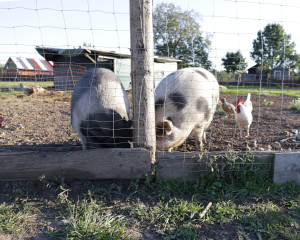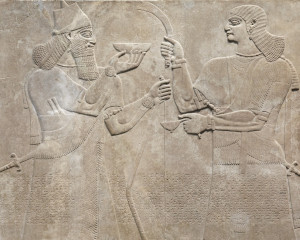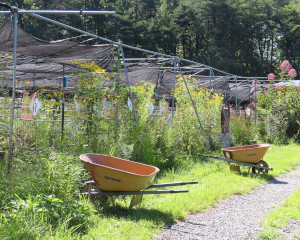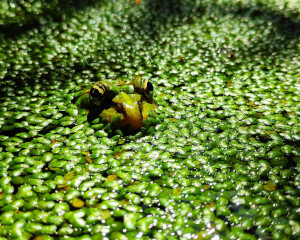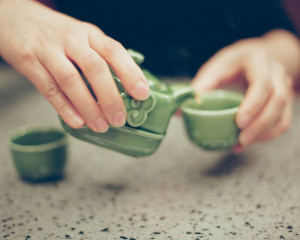World Sensorium: The World Social Olfactory Sculpture
“The world is a work of art that gives birth to itself.”
Nietzsche
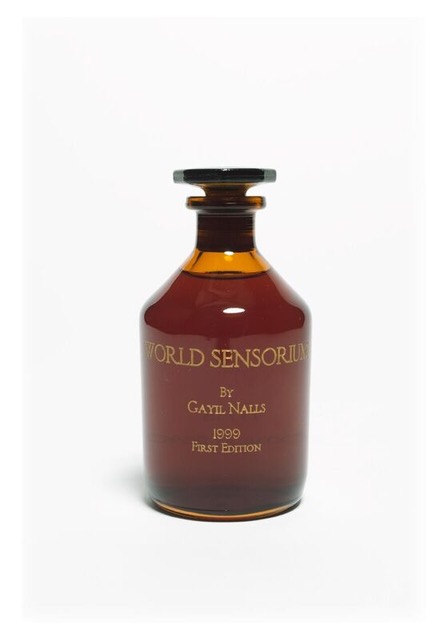
World Sensorium, First Record, Preservation Edition, 2000
World Social Olfactory Sculpture of Aromatic Phytogenic Material
Amber Borosilicate Bottle, 4 x 2 inches, 100ml at 25%
Edition of 18
Created in New York City
© Gayil Nalls
By Gayil Nalls, Ph.D.
Sign up for our monthly newsletter!
World Sensorium is a large-scale, transdisciplinary, scent-based artwork that uses botanical substances most valued by humanity as a medium. It is a world scent comprised of phytoconstituents of essential oil-bearing herbs, shrubs, trees, and grasses, both cultivated and wild harvested from countries all over the world. The plants’ aromatic materials were then formulated into a single global essence.
The plants of World Sensorium were established through a survey with world governments. They are primarily seed producing vascular plants that have been of great cultural and spiritual importance used since ancient times. The research documentation and statistical symbolism of the composition are a special source of data on art, botany, society, culture, and history. They are a component of the conceptual artwork. These, in turn, provide layers of metaphorical meaning in the areas of culture, medicine, mythology, religion, and anthropology. This relationship between humans and plants has helped each flourish in co-evolutionary symbiosis.
History and Significance of the Project
My position has always been that art is not what you see, hear, or smell; rather it is how it makes you feel. My artistic aspiration for the olfactory artwork World Sensorium was to create a work that was more than a metaphor for one world but offered a valuable human experience of the world. The question I asked myself was, “How can art help unite humanity in knowing the importance of nature in culture, and will culture survive without a preserved natural world?” I wanted to create a work as an invisible embodied monument to humanity’s relationship with the planet. To do that, I needed the world as a factual collaborator, so after years of preliminary research, the work became a social sculpture as I embarked on a global survey. The ethnobotanical research and survey process took over five years and established the most culturally and spiritually significant scents from natural flora that triggered olfactory memory for the majority of people of each nation. Olfaction is humanity’s most primitive way of gathering knowledge. Throughout human history, the chemical senses have played important roles as sources of knowledge and stimulation. However, a global investigation of culturally significant natural scents of the world’s countries did not exist prior to the research conducted for the creation of World Sensorium.
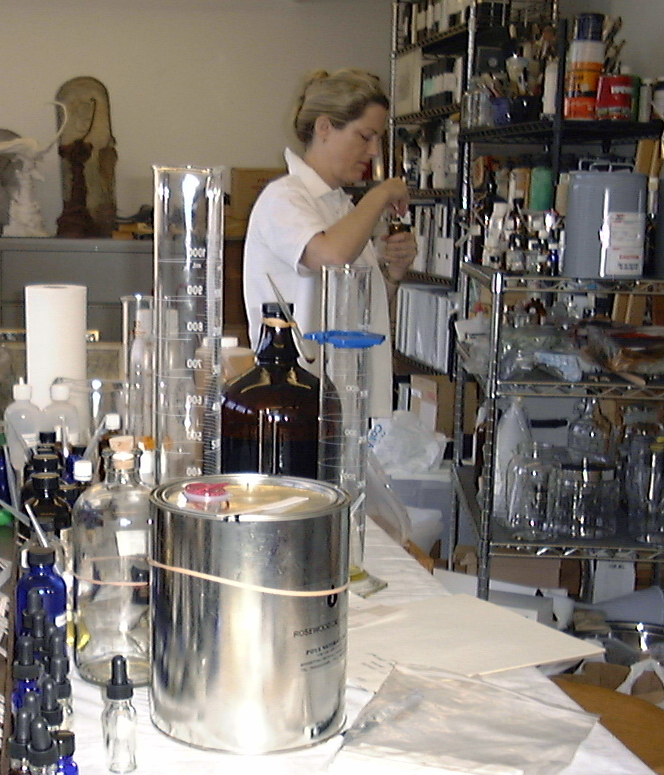
Each plant’s scent was a symbolic olfactory expression of the country’s culture, intrinsic to national identity and heritage, and shared by collective individuals of that nation. Most have been used in cultures since well before Aristotle, who introduced the idea that matter was composed of the elements of fire, air, earth, water, and quintessence, considered to be matter’s spirit or life force. Today, we know that the physical nature of essential oils is composed of complex mixtures of primary metabolites universal in all plants. Secondary metabolites only occur in some plants. These chemicals that abound in World Sensorium are more significant and rarer than others in terms of the odors across essential oils. Also, in World Sensorium, low levels of some chemicals made a significant contribution in odor. An example being Cuba’s Tobacco (Nicotiana tobacum).
Each plant plays a crucial, multifaceted role in daily life that is passed down through customs and traditions from one generation to the next, which elevates them to an iconic species of cultural heritage. This co-evolutionary symbiotic relationship between humans, a biological species, and plants has helped each flourish.
The Premiere of World Sensorium
Aromatic plants are a special category of plants that share the characteristic of exuding aroma. The aromatic substances they produce are primarily essential oils.
The vast majority of these aromatic plants of World Sensorium also have a long history of use for medicinal purposes and aromatherapy. They are also staples of various systems of medicine. Their aroma characteristics are known by the majority of the country’s population due to the presence of volatile compounds that come from the plants’ flower, fruit, foliage, seed, wood or root. The majority of the World Sensorium plants have highly pleasing aromas and are edible or have edible parts, making so many of them important to the countries’ gastronomical traditions.
The years of fieldwork involved interviewing and gathering information from government officials from every country to establish the single most important natural olfactory imprint per nation. This method established the components that synthesized a world scent representing a unifying consciousness of world cultural memory – an olfactory monument to the planet and humanity. World participation in this fieldwork provided deeply insightful quantitative data descriptive of the plant’s meaning and value to the culture while also producing qualitative data that was converted into a formula based on population percentages equating to the volume ratio of each scent.
The individual natural scent constituents were not only political-aesthetic symbols, they also had cultural and therapeutic functions. Some essential oil extracts, experienced through the olfactory domain, have powerful psychological influences at conscious and subconscious levels and affect the part of the mind that processes memories and feelings. The research for World Sensorium conclusively proved that every country has core iconic natural scents that function as memory triggers for the largest number of people living in that country. Early ambient chemosensory stimulation of environmental cultural flora is encoded, stored in long-term memory, and recalled with symbolic meaning. The study provided new insights into the role that natural scents play in olfactory stimulation and cultural association (Nalls 2007).
In 1998 World Sensorium was honored by the U.S. President’s Committee of the Arts and Humanities and granted sponsorship by the United Nations Educational, Scientific and Cultural Organization (UNESCO) as a “highly original cultural initiative” launched with the International Year of Culture and Peace, an experience “leading to better understanding and collaboration among nations” (UNESCO 1998).

World Sensorium, the global essence, came into finished physical existence at the end of 1999. On New Year’s Eve 2000, it premiered at “Times Square 2000, The Global Celebration at the Crossroads of the World”. Microencapsulated paperworks, each containing 10 grams of World Sensorium, cascaded down over Times Square into a sea of 2 million people. Individuals pulled open the paperworks for an unprecedented participatory sensory experience.The world scent was also featured in Washington, D.C.’s Millennium Around the World event and the Vatican’s Millennium Jubilee in Rome, Italy. World Sensorium continues to be exhibited in art galleries, museums, and public spaces internationally.
The message of World Sensorium is organically embodied by the alchemic methodological process of its creation and in the molecular properties of the natural materials from which it is made. World Sensorium was created to provoke memory in the appreciation of nature and the comprehension of humankind as a dependent participant. As people began to experience the work, it triggered the next stage of research, a new and deeper inquiry to evaluate of the phenomenological experience of olfactory art. In 2018, a video piece Experience World Sensorium documented the extended effects that World Sensorium had on participants in a controlled environment (Nalls, Kane 2018).
The Plants that Created World Sensorium
The imprint scents are distinctive aromas critical to each country’s cultural memory. The aromatic plants that rise to high levels of cultural status do so because they have multiple uses and values, used as medicine and food, to build shelter, or for veneration in religious and cultural practices.
Nearly a quarter of the world’s population identified with a variety of the Jasmine (Jasminum) species, hence Jasmine comprises the highest percentage of any plant in the World Sensorium formula. The eleven countries that officially cited Jasmine as their most culturally significant scent are Algeria, Barbados, China, Djibouti, Kenya, Macau, Pakistan, Panama, Paraguay, Saudi Arabia, and Tunisia. However, it is a highly cultural and treasured scent for many more countries too.
Jasmine, with its bright green leaves and very fragrant white, star-shaped flowers, is a member of the oleaceae family with nearly 200 varieties. Native to China, northern India and Asia, its name, Jasmyn, is derived from Arabic and means “gift from God.” It was brought to North Africa and Spain by the Moors in the mid-1500’s, and then introduced to France. Varieties of Jasmine have been cultivated around the world for centuries.
Jasmine is often associated with sensory pleasure and its aromatic bioactive compounds are highly beneficial. Through the course of the research, the soothing smell of jasmine flowers sensed in drifting waves through the night air was identified as one of the most beloved and enduring scents to a large number of people from many nations. They said they had never rested better or more peacefully than in a situation where that experience was possible.
In 2010, Haans Hatt, a German scientist at Ruhr-Universität-Bochum, found molecular actions of Jasmine to be more effective than a sleeping pill (Hatt 2010). There are many plants in World Sensorium that manufacture amazing chemicals with the intrinsic ability to influence both mood and the physical state of the body. Jasmine is a prime example of one plant that does this.
The cultural practices now associated with the flower and its scent, like other cultural scents, were originally important to people’s survival. This is the reason they became adaptive traditions, so that future generations could have those health benefits. There are many elaborate cultural traditions that have evolved around the Jasmine flower in many countries, where it is grown indoors and in gardens, used as an herb and in medicine, as well as for making perfumes and garlands.
In China, many species of Jasmine are used medicinally. To treat hepatitis, cirrhosis of the liver and dysentery, the flowers of Jasminum officinnale var. grandiflorum are used (Zhao 2009). For tumors, skin ulcers and conjunctivitis, the flowers of Jasminum sambac are used (Kalaiselvi 2013). The root of Jasminum sambac is used to treat circulation, headaches and joint pain. Both are part of the World Sensorium formula. Additionally, Jasmine is recognized for its therapeutic use as a remedy for bronchial and respiratory ailments. Jasmine tea, so popular in China, is consumed both for enjoyment and its beneficial properties. Government and cultural representatives for China said the scent represents their higher self. Because Jasmine is a galactagogue, increasing the flow of mother’s milk, and an antispasmodic, relieving uterine pain of childbirth, it is widely used as an aid to female reproductive health (Lawrence 2015).
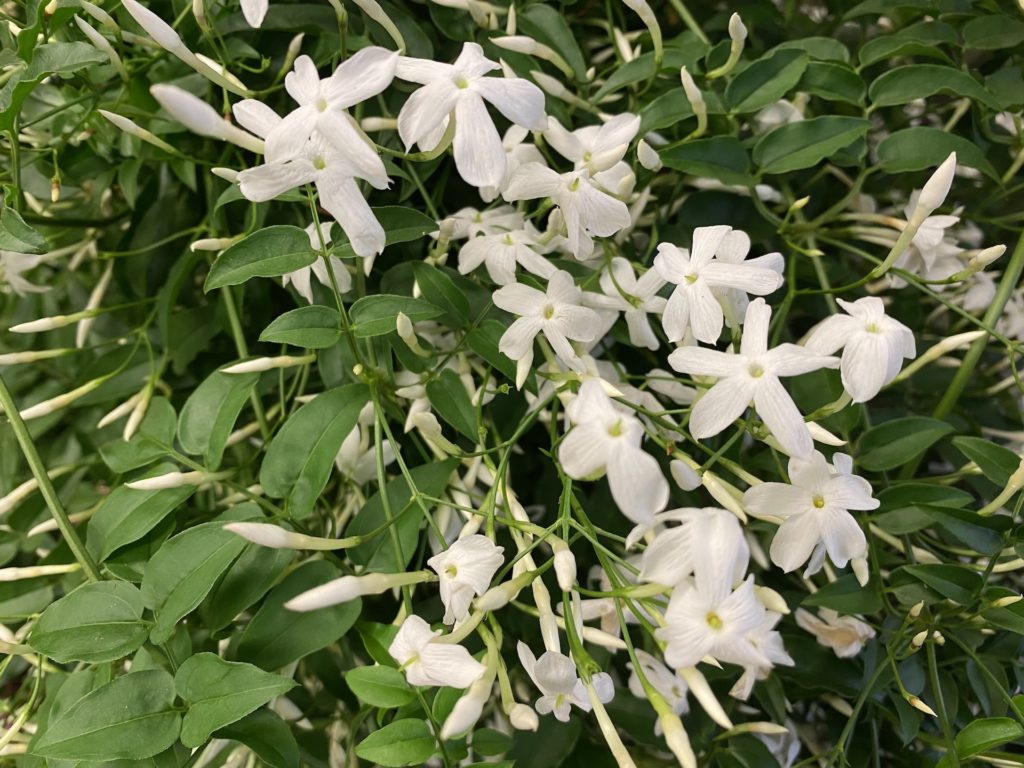
In Pakistan, Egypt and many other places in the world, Jasmine flowers are braided into garlands and worn. In Pakistan and parts of India, it is tradition for the flowers to cover wedding beds. The experience of sweet-smelling Jasmine is always a pleasure and gratifying, and in the Middle East it is said to encourage social harmony and so is often used in religious ceremony. In the Mediterranean, Jasmine is still planted at the entrance of houses to welcome those who pass the threshold.
Eight countries identified various species of Rose (Rosa) as the plant scent most culturally significant for their nation: Afghanistan, Bangladesh, Bulgaria, Iran, Luxembourg, the Maldives, Nigeria, and Syria. France considered Rose the most culturally associative scent other than Lavender (Lavendula). Rose has long been associated with Islamic religious traditions. Iranian representatives described the monumental production and use of rosewater in their many religious observances, the most significant of which being the annual Muslim hajj pilgrimage to Mecca in Saudi Arabia. When the Great Mosque is washed in rosewater, it is said that the scent of Rose can be smelled miles away.
The aromatic gum resins (dried tree sap) of Frankincense (genus Boswellia) representing Oman and Yemen, and Myrrh (genus Commiphora) representing Somalia, have been used since ancient times in spiritual, religious, and ceremonial rites. They both are traditionally used as incense and as anointing oil and are greatly valued for their aid in meditation, prayer, and medicine. Myrrh was chosen by Somalia and the oleogum was distilled from wild harvested Myrrh native to Somalia. Juniper (Juniperus) was identified by Bhutan, Kyrgyzstan, Mongolia, and Tajikistan as an associative olfactory cultural cue because of its long history of use as incense for rituals of purification. Some species of Frankincense (Boswellia var. ovalifoliolata, var. pirottae) are decreasing in numbers and considered vulnerable by The International Union for Conservation of Nature (ICUN) Red List. Some species of Myrrh (Commiphora var. stocksiana, var. wightii) are classified as endangered and critically endangered by the ICUN Red List.
Many of the scents of World Sensorium are from foods and spices that are bountiful in substances that benefit human health. The smell of Coffee and the Coffee Flower (Coffea) were identified by Costa Rica, Cote D’Ivoire, Ethiopia, Rwanda, Uganda, and Venezuela. The majority of Coffee species are either vulnerable, endangered, or critically endangered. Georgia, Germany, Moldova and Uzbekistan identified the scent of Grapes (Vitis) as highly associative. Other fruit scents identified include Coconut (Cocos nucifera) by the Congo, Kiribati, Mozambique, Papua New Guinea, Pitcairn Islands, and Tokelau, Banana (Musa paradisiaca sapientum) by Cameroon and Cape Verde, pineapple (Ananas comosus) by Antigua and Barbuda, Guinea, Sierra Leone and Swaziland, and Mango (Mangifera indica) by Brazil, Haiti, and Zambia. The scent of spices includes Nutmeg (Myristica fragrans) by Grenada, Paprika (Capiscum annuum) by Hungary, Allspice (Pimenta dioica) by Jamaica, and Savory by Bolivia. Comoros, Madagascar, Mexico, Réunion, and Tonga identified Vanilla (Vanilla planifolia) (a product of the orchid) as the most culturally important scent. However, it is also an endangered species on the ICUN Red List. When Vanilla was introduced to the United States in the early 1800s, it rapidly became a beloved food ingredient, and later was made popular in fragrance. For generations now, it has been enjoyed as a comforting and memory provoking scent and flavor.
Possibly the most anthropologically important statement of scent related to cultural practices and social cohesion came from Palau as they recounted the centuries long use of Turmeric (Curcuma longa), mixed with Coconut oil, and how it is used in highly ritualized sequences of celebrations, ceremonies, and healing procedures for mothers after giving birth to their first child. Turmeric has been used in food, as a tea, and as a pain reliever for over two thousand years.
Many trees were identified for their culturally related associations, uses, and resulting odor memories. Species of Pine (Pinus var. nigra, var. oocarpa) were identified by Austria, Honduras, and the United States, citing both curative, culinary, and most famously, as a celebratory symbol for Christmas. Many species of Pine are also considered vulnerable, endangered, or critically endangered.
Other countries besides Réunion and Togo identified indigenous Grasses (Cymbopogon). They are Central African Republic, Lesotho, Mali, the United Kingdom, and Western Sahara. The United Kingdom felt that all four of its countries were united as people who know the scent of the sea wind rolling through ‘lands of grasses.’ The Republic of Ireland said that the smell “turf” (also called peat, compressed plant matter from peat bogs) was an important part of their history and culture. People remembered the smell of burning turf and thought of it as being able to prompt vivid memories of time with family and friends where stories were passed down to the younger generation. Ireland is rapidly stopping turf extraction and revaluing bogs for their extremely important climate contribution. When bogs are drained for cutting, the organic matter breaks down releasing greenhouse gases, and more emissions are released when the bricks are burned. Ireland is rapidly moving to sustainable energy, especially wind, in order to meet their climate goal of having net zero emissions by 2050. Most people have stopped burning peat, but on special occasions they may burn a little piece like incense to conjure the warm feelings its aroma brings.
For each scent, an official statement was drafted by national representatives explaining the cultural significance of the fragrance. These ranged from obvious statements of the plant’s importance (e.g., Norway’s selection of Norwegian Spruce (Picea abies), because it is so prevalent and the tree is used in the home at Christmas) to more deeply vested ties with the plant on a personal and communal level (e.g., Palau’s selection of Turmeric, as “it reminds you that a new mother has given birth and that she is ready for her baths of boiling water.”) For updated information on the conservation status as well as cultural context of the plants in World Sensorium, visit the country pages at worldsensorium.com.
The Scent of Unity
World Sensorium, the olfactory social sculpture, taps the potential of the olfactory brain to create knowledge and build resilience through olfactory aesthetics. In 2017, the World Sensorium/Conservancy was created to further scale adaption, climate mitigation, and plant conservation.
With the establishment of World Sensorium/Conservancy, I ask myself, “Can collective potential be a material of art? Can we scale the conservation movement to the needed level, making every community a conservation community?”
World Sensorium establishes an intrinsic evolutionary partnership between the immense cultural and medicinal value of flora and the need to preserve it. These plants depend on us to protect their welfare and have a very limited safety net. Not only are sustainable practices necessary for the preservation of the natural environment, but also to preserve the cultural and spiritual practices that have sustained the human will to live since the beginning. It is necessary to strengthen and grow the conservation movement in order to protect aromatic and medical plants and all biodiversity.
References:
ICUN Red List of Threatened Species. Available: https://www.iucnredlist.org/
Last accessed 6 December 2021.
Kalaiselvi M, Narmadha R, Ragavendran P, Vidya B, Gomathi D, Raj CA, Starlinraj T, Gopalakrishnan VK, Uma C, Kalaivani K. Chemopreventive effect and HPTLC fingerprinting analysis of Jasminum sambac (L.) Ait. Extract against DLA-induced lymphoma in experimental animals. Appl Biochem Biotechnol. 2013 Feb;169(4):1098-108. doi: 10.1007/s12010-012-0045-6. Epub 2013 Jan 10. PMID: 23306882.
Lawrence R., Hüttel E. 2015. 4.13 – Alternative remedies, vitamins, and minerals,
Editor(s): Christof Schaefer, Paul Peters, Richard K. Miller. Drugs During Pregnancy and Lactation (Third Edition). Academic Press, 2015. p803-811. ISBN 9780124080782. https://doi.org/10.1016/B978-0-12-408078-2.00038-X.
Nalls G. (Producer) Kane F. (Director) 2018. Experience World Sensorium [Video], 25:03. Youtube. https://www.youtube.com/watch?v=JK6yV9TwAS4&t=762s
Nalls G. (2008.) World Sensorium: The Theory, Practice and Significance of the World Social Olfactory Sculpture (doctorate dissertation). University of East London, UK.
Nalls G. (2007.) The importance of natural olfactory stimulation on the perception of well-being and happiness: A global investigation. Edited by, Linking Affect to Action: Critical Contributions of the orbitofrontal cortex. Schoenbaum, G, Gottfried, J., Evanston, Murray & A., Ramus, S. Annals of The New York Academy of Sciences 1121. p676.
O. A. Sergeeva, O. Kletke, A. Kragler, A. Poppek, W. Fleischer, S. R. Schubring, B. Goerg, H. L. Haas, X.-R. Zhu, H. Luebbert, G. Gisselmann, H. Hatt. Fragrant dioxane derivatives identify 1 subunit-containing GABAA receptors. Journal of Biological Chemistry, 2010; DOI: 10.1074/jbc.M110.103309
UNESCO Sponsorship Letter ‘DG/22/138’. 5 September 1998. Signed The Director General Frederico Mayor.
Zhao G, Yin Z, Dong J. Antiviral efficacy against hepatitis B virus replication of oleuropein isolated from Jasminum officinale L. var. grandiflorum. J Ethnopharmacol. 2009 Sep 7;125(2):265-8. doi: 10.1016/j.jep.2009.06.030. Epub 2009 Jul 4. PMID: 19580857.

Gayil Nalls, Ph.D. (United States) is an interdisciplinary artist creating at the forefront of science-art practices and theoretical discourse. Nalls uses art as a catalyst for the world’s engagement in joining together to heal the planet. She is an internationally known pioneer of olfactory art and is the creator of World Sensorium, the olfactory social sculpture. In 2017 Nalls founded the World Sensorium/Conservancy, and in 2021 launched WS/C’s journal Plantings.
Similar material was published in 2008 in World Sensorium: The Theory, Practice, and Significance of the World Social Olfactory Sculpture, and more recently in The International Journal of Professional Holistic Aromatherapy, Volume 11 Issue 1, Summer 2022

As Ireland transitions from the rich, smoky scent of peat-burning to a more sustainable future, its olfactory heritage is evolving. What will become the next iconic aromatic symbol of Ireland?
Click to watch the documentary trailer.


